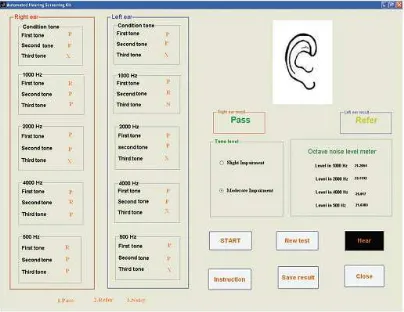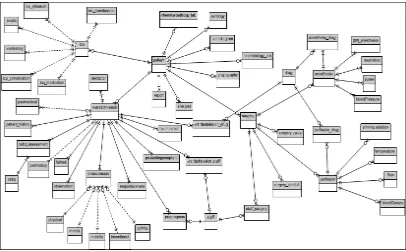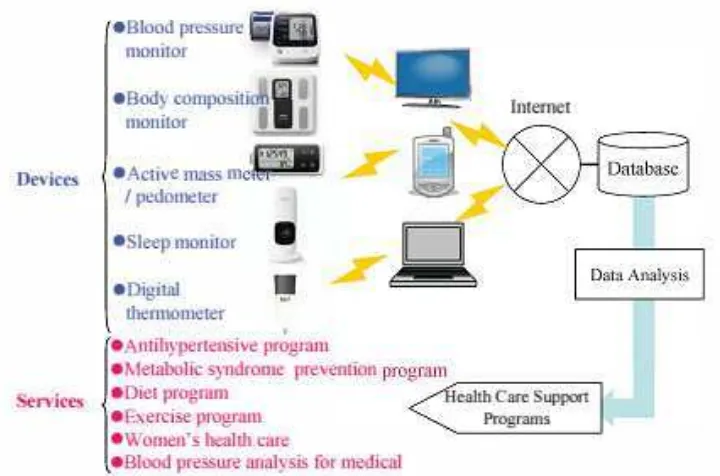CENTRALIZED DATABASE SYSTEM FOR AUTOMATED HEARING SCREENING
MOHD SAAD BIN HAMID
MASTER PROJECT REPORT SUBMITTED IN PARTIAL FULFILMENT OF THE REQUIREMENTS FOR THE DEGREE OF
MASTER OF ENGINEERING
FACULTY OF ENGINEERING AND BUILT ENVIRONMENT UNIVERSITI KEBANGSAAN MALAYSIA
BANGI
SISTEM PENGKALAN DATA BERPUSAT UNTUK SARINGAN PENDENGARAN AUTOMATIK
MOHD SAAD BIN HAMID
LAPORAN PROJEK SARJANA YANG DIKEMUKAKAN UNTUK MEMENUHI SEBAHAGIAN DARIPADA SYARAT MEMPEROLEH
IJAZAH SARJANA KEJURUTERAAN
FAKULTI KEJURUTERAAN DAN ALAM BINA UNIVERSITI KEBANGSAAN MALAYSIA
BANGI
DECLARATION
I hereby declare that the work in this thesis is my own except for quotations and summaries which have been duly acknowledged.
iv
ACKNOWLEDGEMENTS
First of all, I want to thank to ALLAH for everything happen in my life. Second I would like to thank my supervisor, Ir. Dr. Nasharuddin Zainal for his kindness, guidance and motivation for me to accomplish this project and the most important thing is the chance for me to participate and gain new experience in his research activities.
Next I would like to express my gratefulness to my beloved wife, Amiza Sani Ahmad, my daughter Nurul Fatihah and my son Ahmad Muizz Naufal for their uncountable supports and motivation and especially for being together with me in happy and sorrow. Not to forget my beloved family for undeniable support especially my parents, Hamid Bin Din and Halimah Binti Mat Zin. For my brothers and sister, thank for your support and understanding.
I would like to thank to my sponsor Ministry of Higher Education and my employer, Universiti Teknikal Malaysia Melaka for the continuous financial and moral support during my studies.
v
ABSTRACT
vi
ABSTRAK
vii
CONTENTS
Page
DECLARATION iii
ACKNOWLEDGEMENT iv
ABSTRACT v
ABSTRAK vi
CONTENTS vii
LIST OF TABLES x
LIST OF FIGURES xi
LIST OF ABBREVIATIONS xiii
LIST OF APPENDICES xiv
CHAPTER I INTRODUCTION
1.1 Overview 1
1.2 Problem Statement 2
1.3 Research Objective 3
1.4 Scope of Works 3
1.5 Organization of Dissertation 4
1.6 Summary 4
CHAPTER II LITERATURE REVIEW
2.1 Introduction 5
2.2 Background 5
2.3 User Interface Design Rules 7
2.4 Database Design 8
2.5 Database System Configuration 9
2.6 Web Application Security 10
2.7 Structured Query Language (SQL) Injection 12
2.8 Cross Site Scripting (XSS) 14
viii
CHAPTER III METHODOLOGY
3.1 Introduction 16
3.2 Problem Formulation 16
3.2.1 Data Transaction Method 16
3.2.2 Protection of Data from Security Threats 17
3.3 Proposed Method 17
3.3.1 Centralized Database Design 17
A. Analyzing Data Requirements 18
B. Database Fields Type 22
C. Modeling Database 25
3.3.2 User Interface Design for Web Application 26
3.3.3 Back End Programming 28
A. User Authentication 29
B. Session Management 31
C. Report Generation 32
3.3.4 Securing PHP Code 32
3.3.5 Hearing Screening Software 33
3.3.6 Offline Reliability 35
3.4 Project Flow 36
3.5 Summary 36
CHAPTER IV RESULTS AND DISCUSSIONS
4.1 Introduction 38
4.2 Hearing Screening Database Web Application 38
4.2.1 Implementation of Database Tables 39 4.2.2 Implementation of Web Application Interface 44
4.2.3 SQL Injection Attack Test 50
4.3 The Implementation of Autokit Software 52
4.4 End User Test on Autokit Software 57
4.5 Summary 58
CHAPTER V CONCLUSIONS
5.1 Introduction 59
5.2 Conclusion 59
5.3 Recommendations 60
5.3.1 Study on Performance Evaluation of
ix
5.3.2 Multi-Tone Intensity for Hearing
Screening Procedure 61
x
LIST OF TABLES
Table No Page
3.1 Results Interpretation 19
3.2 User Table 20
3.3 Proposed Results Table 22
3.4 Proposed Users Table 24
3.5 Proposed Test Centers Table 25
xi
LIST OF FIGURES
Figure No Page
2.1 Graphical User Interface 6
2.2 Entity Relationship Diagram for Smart Medical Clinical System 9
2.3 Overview of System Configuration 10
2.4 Initial Revision Types 12
2.5 Simple Login Page 13
3.1 GUI of Automated Hearing Screening Kit 18
3.2 AutoKit Prompt User’s Information 19
3.3 Security, Functional and Ease of Use Triangle 21
3.4 Data Centered Architecture 21
3.5 Web Application Interface Layout 27
3.6 CSS style sheet class definition 28
3.7 Authentication Process 30
3.8 Session Management 31
3.9 Securing Error Reporting 33
3.10 MATLAB GUIDE Editor 34
3.11 Basic Layout of Hearing Screening 34
3.12 Local Storage Mechanism 35
3.13 Flowchart of the Project 37
4.1 Hearing Screening Database Structure in phpMyadmin 39
4.2 Implemented Results Table 40
4.3 Results Table Statistics 40
4.4 Implemented Users Table 41
4.5 Users Table Statistics 41
4.6 Implemented Test Centers Table 42
4.7 Test Centers Table Statistics 42
4.8 Audiology Center Table 43
4.9 Audiology Center Table Statistics using MyISAM 43
xii
4.11 Web Application Login Page 45
4.12 Test Results Features 45
4.13 Hearing Screening Sample Data 46
4.14 Sample Test Result 47
4.15 Test Center Information Management 48
4.16 Users Information Management 48
4.17 User' Permission Level Check 49
4.18 Audiologist User Level Access 49
4.19 Teacher User Level Access 49
4.20 Session Management Check 50
4.21 SQL Injection Attack Test 51
4.22 SQL Injection Failed 52
4.23 Initial Window 53
4.24 Test Description Window 53
4.25 Second Step of Test 54
4.26 Test Complete 55
4.27 User’s Details Submission 56
4.28 Preferences Panel 56
4.29 End User Test 57
xiii
LIST OF ABBREVIATIONS
ANSI American National Standards Institute
ASHA American Speech-Language-Hearing Association CLI Command Line Interface
CSS Cascading Style Sheet ERD Entity Relationship Diagram
GUIDE Graphical User Interface Development Environment GUI Graphical User Interface
HTML Hypertext Markup Language HER Electronics Health Record HCI Human Computer Interaction SQL Structured Query Language ODBC Open Database Connectivity PC Personal Computer
UKM Universiti Kebangsaan Malaysia
WWW World Wide Web
XSS Cross Site Scripting Attack
xiv
LIST OF APPENDICES
A1 Hearing Screening Database - SQL Dump File 65
A2 Database Modeling Using MySQL Workbench 67
1
CHAPTER I
INTRODUCTION
1.1 OVERVIEW
Nowadays, we live in the era where most of the products, ranging from consumer, industrial, medical and up to military products require human interaction. This interaction requires some interface for human to operate the product. So, manufacturer of the products need to implement good interface which exhibit the usability of the products. Basically, there are two types of interface to help users to interact with the product. The first type of interface is the Command Line Interface (CLI). In the early era of computer most of the applications were written as CLI based, where the user friendly usability factor was not the main focus of the person who develops the interface. For the CLI, the interaction between user and the application mostly by using keyboard. The user will enter the predefined text as command through keyboard to the application to perform the specific action requested by user. However, nowadays most of the developed end user applications focus on the second interface, the Graphical User Interface (GUI) as mentioned by in related paper (Rauf et al. 2010). The application that implements the GUI handles the interaction between user and application mostly by using keyboard and mouse. User will move the cursor on the screen to the desired graphical user interface elements to execute the required action.
2
There are various types of data that can be stored and processed, from day-to-day application data, scientific engineering data and even as Electronics Health Record (EHR).
Centralized database software is a type of software that enables simultaneous updates from multiple queries containing data from multiple users. It can be used to store, update and also delete the stored data. Centralized database software enables users from various computer platforms to store their data in one place. Regardless what happen to the users’ computer hardware, the data stored in the centralized database will remain safe.
1.2 PROBLEM STATEMENT
As mentioned in a paper (Gunter 2005), the EHR is an evolving concept defined as a longitudinal collection of electronic health information about individual patients and populations. EHRs may contain various types of data ranging from demographic, medical history information, personal information and even laboratory test result. This valuable information will provide more data for health practitioner to identify any possible problem or to predict the health pattern from the stored EHRs. So it is crucial to develop centralized database software for storing electronic health records.
3
by using internet connection. Security authentication procedure has to be implemented to protect the privacy of the data.
The original Autokit software also has to be redesign in term of GUI in order to submit the results into the centralized database. The mentioned clinical test has been performed to the subjects aged between 19 and 79 years old (Gan et al. 2012). So the GUI also has to be redesign to help the end users which are normally not an IT savvy user. It should minimize technical configuration and also should focus on broader range of users, the school children, teenagers and adult users. This will help the user to use the software effectively.
1.3 RESEARCH OBJECTIVE
The objectives for this research as follows:
To implement and configure centralized database for storing test results.
To redesign the graphical user interface (GUI) for Hearing Screening Test standalone application.
To develop web application interface for database management.
1.4 SCOPE OF WORKS
4
MATLAB based software and Web based software will be configured to interact with the centralized MYSQL server.
1.5 ORGANIZATION OF DISSERTATION
This report contains five chapters. The arrangement of the chapter as follows:
Chapter I provides introduction on current style of software. It also discuss about the need of the proposed software as well as the problem statements that motivate the development of the software.
Chapter II mainly includes the literature review and fundamental concept on designing the software as well as the related security issues with web application.
Chapter III explains the methodologies implemented throughout the project. The problem formulations are first identified and the countermeasure proposed to tackle the issues also presented in this chapter.
Chapter IV discusses about the results obtain in this project where it contains figure and tables related to the project. Software assessment result also will be presented in this chapter.
The final Chapter V discusses about the conclusions and future work recommendations based on the results presented and analyzed in Chapter IV.
1.6 SUMMARY
CHAPTER II
LITERATURE REVIEW
INTRODUCTION 2.1
In order to have a better understanding of this project, it is necessary to discuss the overall background related to basic technology used to complete the software. This chapter highlights the needs for hearing screening together with the related work about the earlier prototype. Then the fundamental explanation pertaining to the process of developing or designing Graphical User Interface, database system as well as the system configuration will be discussed in this chapter. Finally, the security issue related to web application security will be discussed in greater details.
BACKGROUND 2.2
6
There many variation of hearing screening software published. As mentioned in paper (Gan et al. 2012), the authors successfully developed a computer based hearing screening device. The software was developed using MATLAB environment. It is a standalone computer based program with the capability of real time noise level monitoring. It is to confirm that the screening is performed in an environment that follows to the standard (American National Standards Institute S3.6-2004 standard). Figure 2.1 illustrates the interface of the program (Gan et al. 2012). The software stores the result in the Microsoft Access file through Open Database Connectivity (ODBC) connection. However, the test results of the hearing screening only available on the installed computer. The next section of this report will explain the relationship between the paper and the propose work to be implemented to extend the capability of the software.
7
USER INTERFACE DESIGN RULES 2.3
As mentioned in the earlier section, the purpose of having GUI is to enable user friendly factor in the software interface. This is part of Human Computer Interaction (HCI) field. It involves interaction between users (human) and computer (machine). Typical PC application developed with GUI obtains input from user by using keyboard and mouse. User interface design creates effective communication medium between human and a computer (Pressman 2010). So, a software designer should try follows the guiding principle to design the user interface. Theo Mandel in his book (Mandel 1997) highlights three golden rules as user interface design principle.
8
DATABASE DESIGN 2.4
Almost all of the modern databases are relational databases. Its purpose is to provide facilities for fast storage and able to retrieve large quantity of data. One of the characteristic of relational database is to have unique key to identify each rows in a table. It will help to perform sorting of the rows in the table based on their keys. In relational model, every data will be stored once in the same location. The purpose is to avoid data redundancy in relational database. In relational database, we can specify type of data to be stored in the table by constraining the field type into specific type (dates, numbers, small text and other type) and field length into specific length. By following the relational database standards, we should be able to move our database into different platform freely without having to worry that our database will not working. For the electronic health record, as mentioned by Taylor, the schema of any proposed relational database needed to store such clinical data is not known until the information is collected and ready for inclusion into the database (Taylor et al. 2004). So the designed must be ready for future growth.
In order to achieve the level, it is advisable to perform database normalization. A good database design practice also encourage database to be normalized. Database normalization has some significant improvement in terms of the efficiency and maintainability of the database. It enables us to use simple Structured Query Language (SQL) queries to perform complex data selection. It helps to maintain integrity of the data for reliable data storage. As mentioned by Stephens and Plew (2001) the normalization of database will help to reduce redundancies of data in the database. Normalization also provides the crucial aspect of database system which is the scalability of the database as well as the system. Scalability helps to deal with future growth of the system. The database will be able to maintain the performance as the user s’ data grows.
9
database by using data modeling tool such as MySQL Workbench. The MySQL Workbench will produce a graphical database diagram or known as the Entity Relationship Diagram (ERD). As mentioned in paper (Sani et al. 2012), ERD is a conceptual database design which is a graphical representation used to depict efficient database design. The ERD will illustrate the relationship of the available entities in the database and its attributes. It is also shows the relationship between entities in the database. By modeling the database earlier, it is easier to analyze any logical error before the creation of the database. The Figure 2.2 illustrates the ERD implemented for Smart Medical Clinical System.
Figure 2.2 Entity Relationship Diagram for Smart Medical Clinical System Source: Sani et al. 2012
DATABASE SYSTEM CONFIGURATION 2.5
10
database. For the configuration of the hearing screening database, the database will receive multiple results from multiple test centers such as schools. Then the Certified Audiologists will be able to view and analyses the test results from the services provided from the hearing screening web application. The web application will provide more information for execution of detailed test as well as planning for hearing loss prevention based on demographic and geographical information from the database. This will be based on the system implemented by Nakajima et al. (2012) except that the types of services and equipment might be different.
Figure 2.3 Overview of System Configuration Source: Nakajima et al. 2012
WEB APPLICATION SECURITY 2.6


